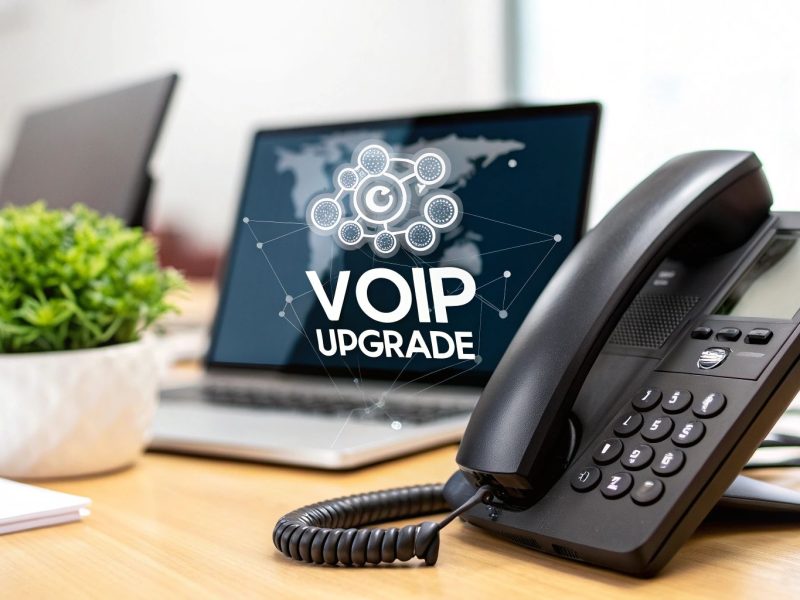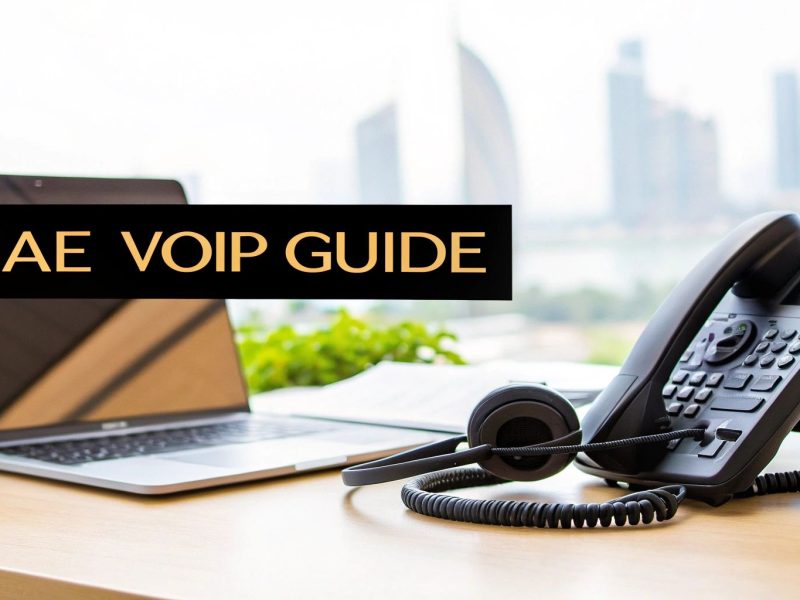Forget the old image of a room full of agents just answering phones. Today’s call center is the command center for your entire customer relationship strategy. Its role has grown far beyond just taking calls; it's now about managing the complete customer journey, no matter how a customer chooses to reach out. You'll often hear the terms "call center" and "contact center" used to mean the same thing these days, and that's because they both refer to this central hub of communication.
What Is a Modern Call Center?

Think of your business as a starship on a mission to win customer loyalty. Your call center is mission control. Every signal that comes in—whether it's a phone call, an email, a social media comment, or a live chat message—is a transmission from your customers that needs to be routed, understood, and handled with care.
This mission control doesn't just react to problems; it actively coordinates the response. It makes sure the right expert handles each specific issue, gives them the background information they need, and keeps track of every interaction. This integrated approach saves customers the headache of repeating their story to multiple people in different departments.
The Core Components of Mission Control
A truly effective call center runs on three essential pillars working together. Get these right, and you're well on your way to building a great brand reputation through positive, efficient customer experiences.
- People: These are the agents and supervisors on the front lines, talking to customers every day. Understanding the roles of call center representatives is a great starting point.
- Processes: These are the playbooks for handling everything that comes your way, from simple account questions to complex troubleshooting.
- Technology: This is the toolkit—CRM systems, call routing software, and analytics dashboards—that helps your team work smarter, not harder.
When these three elements click, your call center stops being a simple cost of doing business and becomes a strategic asset. It transforms into an engine for keeping customers happy and growing your bottom line. It also becomes your best source of raw customer feedback, giving you direct insight into what’s working and what isn’t.
By centralizing customer interactions, a modern call center ensures consistency and quality across all touchpoints, turning every conversation into an opportunity to strengthen the customer relationship.
From Reactive to Proactive Engagement
The biggest change in the call center world has been the move from just reacting to problems to proactively getting ahead of them. Instead of just waiting for the phone to ring with a complaint, modern operations use data to see trouble coming.
For example, your analytics might show that customers who buy a certain product almost always call with the same question about setting it up. A proactive call center can use that insight to automatically send a helpful "how-to" email or SMS right after the purchase. This simple step can slash your inbound call volume and give your customers a much smoother experience—a hallmark of a top-tier call center service that boosts both efficiency and satisfaction.
Choosing Your Call Centre Deployment Model
One of the first, and biggest, decisions you'll make when setting up a call centre is how you’re going to build it. This isn't just a technical choice—it fundamentally shapes your budget, day-to-day operations, your ability to grow, and how much direct influence you have over the customer experience.
There’s no single "best" answer here. The right model comes down to your company's unique goals, resources, and where you see your business heading. Let’s walk through the three main frameworks that companies rely on: running it yourself, hiring someone else to do it, or tapping into the cloud.
The In-House Call Centre
An in-house call centre is exactly what it sounds like: you build it, staff it, and run it all under your own roof. From hiring agents to buying the tech and managing every shift, it’s all on you. This approach gives you maximum control over every little detail of your customer service.
For companies where deep product knowledge and a strong brand voice are non-negotiable, this level of oversight is a huge advantage. Your agents are your own employees, steeped in your company culture, which often translates to higher-quality, more consistent customer conversations. The catch? That control comes with a hefty price tag. You're looking at a serious upfront investment in equipment, software, and office space, not to mention the ongoing costs of salaries and system maintenance.
The Outsourced Call Centre
The second path is to outsource your call centre to a specialized third-party company. This move can dramatically cut your operational costs since you don't have to worry about buying infrastructure or managing payroll for a large team. Outsourcers are pros at handling high call volumes and often have access to specialized talent.
This is a fantastic option if you need to scale up quickly or deal with seasonal spikes in customer calls without making a massive financial commitment. The main trade-off, however, is giving up direct control. You're handing over a vital, customer-facing part of your business to an external partner. If you don't manage that relationship carefully, you risk inconsistencies in brand messaging and service quality.
The core decision between in-house and outsourced models often boils down to a classic business dilemma: balancing direct control and brand immersion against operational cost and scalability.
No matter which model you choose, success hinges on optimizing key performance metrics. This is about striking the right balance between efficiency and customer happiness.

As you can see, metrics like handle times and call volume have to be carefully managed to keep satisfaction scores high. It's a delicate dance.
The Cloud-Based Call Centre (CCaaS)
A third, incredibly flexible option has become a game-changer for many: the cloud-based call centre, often called Contact Centre as a Service (CCaaS). Here, a provider hosts all the necessary technology in the cloud, and you simply access it through a subscription. This completely sidesteps the need for a big upfront investment in physical hardware.
The agility of CCaaS is its superpower. You can add or remove agent seats almost instantly, which is perfect for businesses with seasonal demand or those in a rapid growth phase. Plus, these platforms usually come loaded with advanced features right out of the box, like AI-driven analytics and omnichannel support.
This model is taking off globally. In the Middle East, for instance, the cloud contact centre market was valued at around USD 1.56 billion and is expected to soar to USD 7.96 billion by 2033, according to Market Data Forecast's report. It's a clear sign that businesses are eager to cut costs while elevating the customer experience.
In many ways, CCaaS offers the best of both worlds. You get cutting-edge technology and incredible scalability, but you can still use your own trained team, giving you control over quality and brand representation.
To make the decision a bit clearer, here’s a side-by-side look at how these three models stack up against each other.
Comparison of Call Centre Deployment Models
| Feature | In-House Call Centre | Outsourced Call Centre | Cloud-Based (CCaaS) Call Centre |
|---|---|---|---|
| Initial Cost | Very High (hardware, software, facilities) | Low (no capital expenditure) | Low (subscription-based) |
| Operational Control | Full and direct control over agents and processes | Limited control; dependent on vendor's policies | High control over your agents and workflows |
| Scalability | Difficult and slow to scale up or down | Easy to scale; managed by the provider | Very easy and fast to scale on demand |
| Technology | Requires internal IT team to manage and update | Access to vendor's tech; limited customization | Access to the latest features; updates are automatic |
| Staffing | Direct hiring, training, and management | Provider handles all staffing and HR | You hire and manage your own remote/on-site agents |
| Brand Consistency | Very High; agents are part of company culture | Moderate to Low; requires strong vendor management | High; your team uses the platform |
Ultimately, whether you choose to build in-house for total control, outsource for cost-efficiency, or adopt a CCaaS model for flexibility, the goal remains the same: to create a seamless and positive experience for every customer who reaches out.
How a Fine-Tuned Call Center Impacts Your Business

It’s easy to look at a call center and see only a cost center—a necessary expense for handling customer complaints. But that’s a dated and dangerously narrow view. A modern, well-run call center is a powerful engine for growth and a strategic asset that directly fuels your bottom line. Its impact goes far beyond just answering the phone efficiently.
At its core, a great call center experience drives customer satisfaction. When people get quick, knowledgeable, and genuinely helpful support, it completely changes how they see your brand. That positive feeling is where real, lasting loyalty begins.
Turning Customers into Advocates
Happy customers stick around. More than that, they become your best marketers. A single great conversation can convince a first-time buyer to come back again, and a history of positive interactions creates a loyal fan who tells their friends about you.
That kind of word-of-mouth advertising is priceless. Building a reputation for outstanding customer service, with your call center as the foundation, gives you a serious advantage in a competitive market. It shows you respect your customers and are invested in solving their problems.
An optimized call center does more than solve problems; it builds relationships. Each resolved ticket and positive conversation adds another brick to the foundation of brand trust and customer loyalty.
This focus on customer experience is a massive driver of market growth. Just look at the call center industry in the Middle East, which has a market size of USD 6.3 billion and is projected to grow at a CAGR of 12.2% through 2033. This boom, especially in places like the UAE and Saudi Arabia, is happening because businesses are realizing that a better customer experience is their key to winning. You can learn more about this trend in the Middle East and Africa Call Centers Market Report.
Making Your Operations More Efficient
Beyond building better customer relationships, optimizing your call center delivers huge benefits internally. Smart, streamlined workflows and the right technology cut down on wasted time and effort, which in turn lowers your operational costs.
Take First Call Resolution (FCR)—one of the most important metrics for any call center. When an agent can solve a customer's problem on the very first try, several great things happen:
- Customer satisfaction soars. Their problem is gone, and they didn't have to chase you down to fix it.
- Operational costs drop. You eliminate the need for follow-up calls, which frees up your agents to help the next person.
- Agent morale gets a boost. It feels good to actually help people, and it reduces the stress of dealing with frustrated customers calling back again and again.
A high FCR rate doesn't just happen by accident. It’s the direct result of solid training, empowering your agents to make decisions, and giving them the integrated tools they need to see a full customer history in an instant.
Unlocking a Goldmine of Business Insights
Maybe the most overlooked role of a modern call center is as a source of invaluable data. Every single conversation is a piece of direct feedback—a clue about what your customers love, what frustrates them, and how they’re using your products.
By analyzing call data, you can spot trends that inform the entire business. A sudden jump in calls about a buggy product feature? That’s critical information for the engineering team. A ton of questions about your service plans? That’s a sign for marketing to clarify its messaging or for sales to explore a new offering.
This feedback loop is incredibly powerful. Your call center stops being a purely reactive support team and becomes a proactive source of business intelligence, helping to guide everything from product development to marketing campaigns.
Key Technologies Driving Modern Call Centers
Technology is the engine room of any modern call center. It’s what gives teams the power to manage customer conversations with remarkable speed and intelligence. Without the right tools, even the best agents would struggle to keep up. This tech stack works behind the scenes to direct traffic, provide context, and automate tasks, freeing up your team to focus on what they do best: solving complex problems.
At the very heart of this ecosystem is your Customer Relationship Management (CRM) system. Think of it as the call center’s central brain—a digital filing cabinet holding every piece of information about every customer. It stores all past interactions, from purchase history to previous support tickets, giving agents a complete picture of who they're talking to.
When an agent can instantly see a customer's entire journey, the conversation completely changes. Instead of forcing the customer to repeat their story, the agent can say, "I see you contacted us last week about a delivery issue. Let's get that sorted right now." This immediate context makes the customer feel heard and valued, turning a potentially frustrating call into a smooth, positive experience.
Smart Routing and Initial Triage
Before an agent even says hello, technology has already done a lot of the heavy lifting. Two key systems, Automatic Call Distribution (ACD) and Interactive Voice Response (IVR), act as the call center's traffic controllers.
An Interactive Voice Response (IVR) system is that automated voice menu you hear when you first call a business—"Press 1 for sales, Press 2 for support." Its job is to quickly figure out why someone is calling and gather basic information without needing a human agent.
Once the IVR identifies the caller's need, the Automatic Call Distribution (ACD) system takes over. Its sole purpose is to intelligently route the call to the most appropriate agent or department based on rules you've set. These rules can be based on:
- Skill-based routing: Sending a technical query to an agent with specialized product knowledge.
- Language preference: Directing a caller to an agent who speaks their native language.
- Agent availability: Finding the next free agent to keep customer wait times to a minimum.
This automated triage ensures customers connect with the right person on the first try, which is a massive factor in improving first-call resolution and overall satisfaction.
The Growing Influence of Artificial Intelligence
Artificial Intelligence (AI) is no longer some futuristic concept; it's a practical and powerful tool in today's call center. AI works alongside human agents to boost efficiency, provide deeper insights, and give customers new ways to get help.
One of the most obvious applications is chatbots and virtual assistants. These AI tools can handle routine queries 24/7, like checking an order status or answering FAQs. This frees up human agents to deal with more complex or emotionally charged conversations where a human touch is non-negotiable.
On top of that, AI-driven sentiment analysis can monitor calls and chats in real-time, detecting customer frustration through tone of voice or specific words. This can trigger an alert for a supervisor to jump in and de-escalate a tough situation before it gets worse. This multi-channel approach is crucial for any modern, responsive customer service operation. You can learn more about how these channels work together by reading our guide on the omnichannel contact center.
AI in the call center isn't about replacing agents. It's about augmenting them—giving them superpowers like instant access to information and real-time insights into customer emotions.
This shift toward smarter, cloud-based technology is a major trend in the region. Contact Center as a Service (CCaaS) is rapidly becoming the go-to model in the UAE and the wider Middle East as businesses embrace cloud communications. The Middle East CCaaS market on fortunebusinessinsights.com was valued at around USD 420.9 million and is projected to hit USD 1.12 billion by 2032, growing at a CAGR of 12.9%. This growth is fueled by the adoption of AI tools like voice recognition and natural language processing to elevate the quality of every single customer interaction.
Actionable Best Practices for Call Center Success

Having the right technology is a huge head start, but what really separates a good call center from a great one are the day-to-day practices. Think of it this way: the best tools in the world won’t deliver results unless your team knows how to use them effectively. Success comes down to your people, your processes, and a relentless commitment to getting better.
Building a world-class operation isn't about some single grand strategy. It's about nailing the fundamentals, over and over again. From the first day of training to how you define success, every single detail shapes the experience you deliver to your customers.
Empower Agents with Comprehensive Training
Your agents aren't just answering phones; they are the voice of your brand. Their confidence and competence are a direct reflection of the training you provide. A truly effective training program has to go way beyond showing them which buttons to click. It needs to build both technical know-how and the critical people skills that make conversations work.
A solid training curriculum should cover:
- Deep Product and Service Knowledge: Agents need to be genuine experts. They should understand not just the features of what you sell, but the real-world problems it solves for your customers.
- Essential Soft Skills: Technical skill without empathy is a recipe for disaster. Ongoing coaching in active listening, de-escalation, and clear communication is non-negotiable for handling tough conversations.
- System and Process Fluency: Agents must be able to fly through your CRM and other systems. Long, awkward silences while they search for information can kill a customer's confidence.
Of course, a key part of success is having enough of the right people on your team. Exploring different high-volume recruiting strategies can provide some valuable ideas for keeping your talent pipeline full.
Establish and Track Meaningful KPIs
As the old saying goes, "what gets measured gets managed." To keep your call center on track, you need to monitor Key Performance Indicators (KPIs). But here’s the catch: focusing too narrowly on a single metric can backfire spectacularly.
For instance, if you obsess over a low Average Handle Time (AHT), you might just be encouraging agents to rush customers off the line. This leads to frustrated customers, unresolved issues, and more callbacks. The key is a balanced scorecard.
A truly effective KPI strategy balances efficiency with quality. It’s not just about how fast an issue was closed, but how well it was resolved in the customer's eyes.
To get the full picture, you need a mix of metrics:
- First Call Resolution (FCR): What percentage of issues are completely solved on the first try? A high FCR is a powerful sign of an efficient and satisfying operation.
- Customer Satisfaction (CSAT): This is direct feedback, usually from post-interaction surveys. It tells you exactly how customers feel about the service they just received.
- Agent Adherence: This metric tracks how well agents stick to their schedules. It's absolutely crucial for workforce management and ensuring you’re staffed correctly for peak times.
Implement Robust Quality Assurance
KPIs tell you what is happening, but a strong Quality Assurance (QA) program tells you why. QA is the process of reviewing agent interactions—calls, chats, emails—to see if they align with your quality standards. This isn't about playing "gotcha." It's a powerful tool for coaching and professional development.
A great QA process delivers specific, actionable feedback that helps agents grow. A QA analyst might notice an agent is brilliant at troubleshooting but struggles to build rapport. That insight gives a manager a perfect coaching opportunity. Our guide on https://cloud-call-center.ae/2025/05/17/call-center-quality-monitoring/ digs deeper into setting up these essential programs.
By weaving together thorough training, balanced metrics, and a supportive QA framework, you build a culture of continuous improvement. This approach not only makes customers happier but also reduces agent turnover by showing them you're invested in their success.
The Future of Customer Engagement
The call center's journey didn't stop at becoming a multichannel hub. It's evolving yet again, from a reactive support line into the strategic core of the entire customer experience. The future is all about smarter technology and meeting customer expectations that are higher than ever—they want personal, proactive, and truly seamless interactions. This isn't about replacing people; it's about giving them incredible tools to see around corners and anticipate customer needs.
One of the biggest shifts we're seeing is the deep integration of AI for predictive analytics. Think about it: a system flags a customer who, based on their behavior, is about to walk away. Instead of waiting for the complaint, the call center can trigger a proactive outreach call from an expert agent. Suddenly, you’ve turned a potential loss into a powerful moment of re-engagement. This moves the whole operation from just solving problems to actively building relationships.
The Rise of Proactive and Personalized Channels
The modern call center's toolbox is getting a major upgrade. We're moving toward more visual and instant support channels that create much stronger human connections.
- Video Support: For tricky troubleshooting or a high-touch sales consultation, nothing beats a video call. It adds a personal element that you just can't get from a voice-only conversation.
- Proactive Outreach: Why wait for a customer to report a problem? Smart businesses are using data to start helpful conversations first—sending a quick SMS, a WhatsApp message, or an email to offer a solution before the customer even knew they needed one.
The takeaway is simple: investing in a forward-thinking call center is a direct investment in your customer relationships and, ultimately, your company's future success.
In a world where customer experience is often the only thing that sets you apart, the call center has become the front line for building a brand people trust. It's no longer just another department; it’s the central nervous system of your customer communication, shaping how people feel about your company one conversation at a time.
Frequently Asked Questions
It's natural to have questions when you're wading into the world of customer service operations. Technology and customer expectations are moving targets, after all. Whether you’re spinning up a new call center or just trying to get more out of the one you have, good answers are gold. Let's tackle some of the most common questions we hear.
We'll clear up a few key distinctions, look at what "success" actually means in this space, and touch on important topics like keeping data safe when you move to the cloud. The goal here is to give you straightforward insights you can put to work.
What Is the Main Difference Between a Call Center and a Contact Center?
The real difference boils down to the channels they handle. A traditional call center is built around one thing: voice calls. It’s a specialized operation designed exclusively for inbound and outbound phone conversations.
A contact center is the next evolution. It's built to manage conversations wherever they happen, across a whole spectrum of digital and traditional channels. We're talking voice calls, sure, but also email, live web chat, SMS texts, and even social media messages. Think of a contact center as the command hub for your entire customer communication strategy, whereas a call center is the voice specialist.
How Do I Measure Call Center Performance?
Measuring performance effectively is all about balance. If you only track one or two things—like how fast your agents end calls—you risk sacrificing quality for speed. The trick is to use a mix of Key Performance Indicators (KPIs) that paint the full picture of what’s going on.
A solid approach includes a blend of metrics like these:
- Customer-Focused Metrics: These tell you how your customers feel. Customer Satisfaction (CSAT) surveys and Net Promoter Score (NPS) are fantastic for getting this direct feedback.
- Operational Efficiency Metrics: These show you how well the machine is running. First Call Resolution (FCR) is a huge one—it tells you how often you’re solving a problem on the very first try. Average Handle Time (AHT) is another classic for gauging efficiency.
- Agent Performance Metrics: These help you understand individual and team productivity. Things like schedule adherence and agent utilization are key for smart workforce management.
When you combine efficiency stats with quality scores, you get a real, honest look at your call center's health. It ensures you’re not just closing tickets fast but actually creating great experiences that keep customers coming back.
Is a Cloud-Based Call Center Secure?
Absolutely. Any reputable cloud-based call center provider—what we often call a CCaaS (Contact Center as a Service) vendor—treats security as their top priority. They know they’re being trusted with sensitive customer data, so their platforms are built from the ground up with security layered in.
Leading providers use a whole host of security measures to keep that data locked down. You'll typically find things like end-to-end data encryption, heavily fortified network architecture, and regular security audits by outside experts to find and fix any potential weaknesses.
On top of that, the best vendors make sure their platforms are compliant with major data security standards around the world. This means following strict rules like GDPR for data privacy and PCI-DSS for protecting payment information. Before you sign on with any provider, just make sure to check their security certifications to ensure they meet your industry's specific needs.
Ready to transform your customer engagement with a secure, flexible, and powerful communication platform? Cloud Move provides enterprise-grade cloud contact center solutions that integrate seamlessly with your CRM and support every channel your customers use. Discover how Cloud Move can elevate your customer service today.




